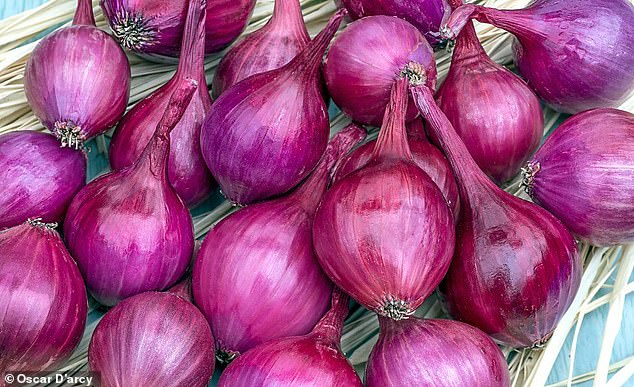Know your onions: Don’t miss out on nutritious ‘piquant’ vegetables in your plot later this year
- Nigel Colborn shares advice for growing garlic, shallots and piquant vegetables
- British gardening expert says garlic is best planted in autumn or late winter
- He advises against being tempted to plant supermarket varieties
Are you feeling sluggish by this ongoing confinement to barracks? Then plant something alliaceous. That’s the fancy word for the onion tribe: garlic, shallots and other piquant vegetables.
Shallots are delicious and should be more widely grown. They develop as clumps of bulbs. Like garlic, they’re grown from divisions or ‘sets’.
As each matures, it splits repeatedly, developing a cluster of little bulbs. Those are easily separated for use and have a milder, sweeter taste than onions and a firmer texture, making them good for pickling.
Garlic grows in a similar way to shallots. ‘Cloves’ are planted individually, developing into large bulbs. But in contrast with shallots, the baby cloves are packed inside the bulb, held in place by a strong tunic that becomes papery and easy to split when the garlic matures.
Perfect for pickling: Dark red Camelot shallots can be started off in pots
Timing your garlic planting can be tricky. The options are autumn or late winter.
But newly planted crops need a cold period before spring. That causes internal splitting which packs the bulb with clusters of baby cloves.
Without cold, the planted clove could become just a big, single bulb. But young garlic plants can be sensitive to poor drainage. So in cold areas with heavy soils, plant spring varieties. Those can still develop properly, despite shorter periods at low temperatures.
THANKS SHALLOT!
Shallots are one of the easiest vegetable crops to grow. They are usually planted in late winter. Unlike onions which mature at summer’s end, they can be ready for harvest in late June or July. A foolproof method is to start the bulbs in pots or seed trays, in a sheltered spot. Plant those out when they’re up and growing.
Midwinter planting is fine if your soil is free-draining and you live in a low rainfall area such as East Anglia. But February or March is just as good and gets the shallots off to a speedy start. Later crops will be harvestable in July.
Shallots are ready when the bulb clusters have stopped expanding. If you bend the tops over gently, a week or so before harvest, that aids ripening.
When gathered and set out to dry, the skins become papery and develop a seal. Store them in a cool and dry place.
BEST VARIETIES
Shallots and garlics are surprisingly variable. When growing either, don’t be tempted to plant supermarket varieties. Many are imported and, though fine to eat, may not be suitable for growing in our climate.
Specialist suppliers and seedsmen offer plenty of choice for home-growing. Marshalls (marshallsgarden.com) stocks an interesting and diverse range of both garlic and shallots.
Shallots can be round, as in Golden Gourmet, or oblong, as in Jermor. For pickling, round types, such as Camelot, are best. Oblong varieties are lovely for cooking. When adding them to casseroles, wash them but leave the skins intact so they hold their shape and flavour. The skins slough off easily, when cooked.
So, to recap, Garlic is hardy but needs well-drained soil. To develop cloves, some varieties need several weeks of low temperatures, others can be spring planted.
You can plant garlic between October and February in cell trays or in a bed outside.
